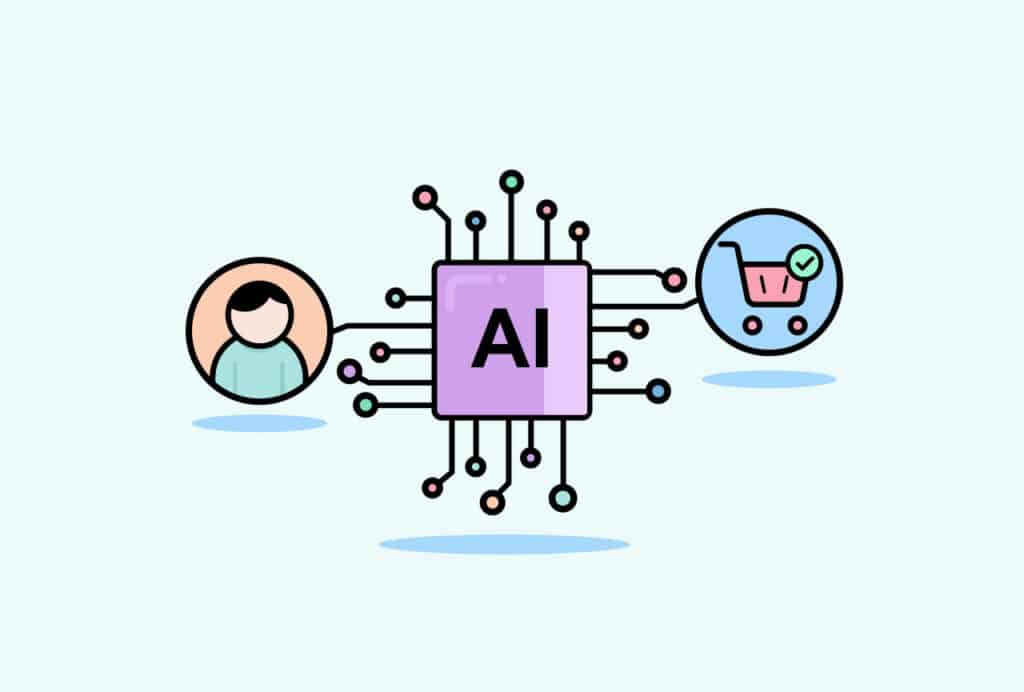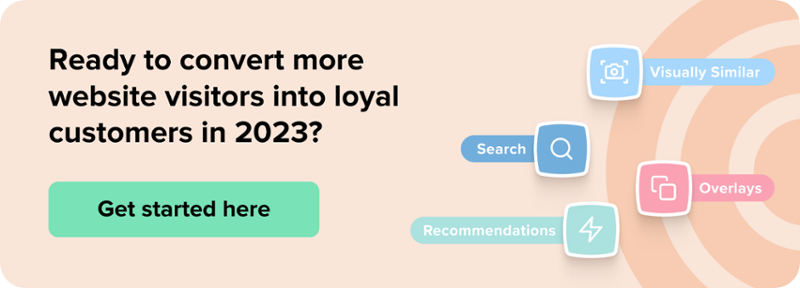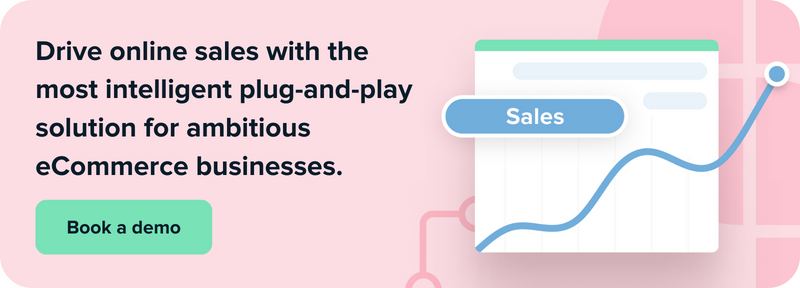AI and the Customer Journey: What You Need to Know
By Bethany Llewellyn • Last updated: Tuesday Apr 23rd, 2024

Artificial intelligence (AI) and machine learning are changing customer experiences for the better.
The global artificial intelligence market is expected to reach about $6 trillion by 2026.1
And the rollout of recent AI-driven projects such as Chat GPT has reignited discussions around AI and revolutionised how we think about this technology on a mass scale.
Machine learning chatbots like ChatGPT and Google’s Bard have been developed to process large amounts of natural language data, and mimic human responses.
The development and accessibility of these tools have brought AI technology to the masses, dominating the cultural conversation in news outlets and social media platforms and working to make the use of AI more commonplace.
As a result, eCommerce stores have more reason than ever to consider how they can utilise AI to their advantage.
Below we discuss how AI is being used to transform the eCommerce customer journey, starting at the point of consideration and product awareness right through to the purchase.
Artificial intelligence in eCommerce
In recent years we’ve seen how retailers can leverage machine learning for improved customer service, as well as the use of AI in on-site solutions that improve efficiency in the long term.
With 84% of eCommerce businesses saying they’re either actively working AI solutions into their business strategy or stating it as a top priority. 2
At its core AI technology is data-driven, which makes it a perfect tool for streamlining eCommerce experiences and leveraging customer data.
Machine learning does all the heavy lifting, effortlessly analysing each shopper and behaviour displayed on-site to:
- Build customer profiles to create a fully personalised experience
- Anticipate consumer browsing behaviour based on similar journeys
- Predicting the products users will respond best to

The benefits of AI for online retailers
The levels of automation afforded by AI save eCommerce marketers precious time, allowing them to truly understand their customers and accurately inform their marketing campaigns.
Implementing AI on your site from chatbots to dynamic content takes the guesswork away from strategy creation.
Providing opportunities to upgrade marketing productivity through automation, improve customer support, and cross-sell and upsell products, AI is a driving force for online retailers.
But how is AI transforming the online space?
The uses of AI in the eCommerce customer journey
The capabilities of AI are seemingly endless. But when it comes to eCommerce, what are the best uses of AI technology and tools?
Below we take a look at how you can incorporate AI throughout the customer journey to navigate users through to the checkout page.
The visual way to shop
Visual AI has taken eCommerce by storm, completely transforming customer experiences.
Visual search tools are commonly associated with early adopters such as Google and Pinterest.
Being able to search via images enables shoppers to find products that have caught their eye without having to find the words to describe them, taking all of the guesswork out of finding the right search terms.
In a new generation of tech-savvy shoppers who gravitate towards visual inspiration, 70% of consumers use Instagram for shopping purposes.3
We know social media shopping works, so how can your online store capitalise on it?
With products like Visually Similar Search, customers can continue to discover products the same way they do on social media.
Allowing your users to search for an item on your site using a picture they may have found on social media allows them to articulate exactly what they want to find and offers product inspiration at every turning point.
Implementing AI-powered tools connects customers to their purchases faster by analysing product imagery and displaying similar items, recommended just for them.
Pro tip: While you may consider upgrading your website to include a Visual Search tool, do not overlook your core Search functionality. Ensure it’s streamlined to deliver faster results and promote quicker conversions.
Personalise using customer segmentation
77% of customers want a more personalised customer experience, making it essential for eCommerce retailers to leverage personalisation in their strategies to meet the individual needs of their customers.4
Targeting the right customer, with the right message, at the right time is one of the most efficient ways to optimise your marketing campaigns and achieve a higher ROI.
Traditional customer segmentation groups your audience based on user demographic and behaviour like:
- Age
- Location
- Time spent on site
- Past purchases
- Product usage
By segmenting customers you are able to make decisions based on each group to maximise the value of each customer.
Adding AI into the mix, machine learning can track real-time data and learn patterns from previous visitors’ behaviour to deliver personalised experiences that future customers are more likely to respond to.
The best part is artificial intelligence adapts through progressive learning algorithms, meaning it will adjust to each customer and their preferences to amplify customer segmentation and create more targeted campaigns.
Data-driven customer segmentation is the best way to ensure that your targeted communications and marketing materials are reaching the right audiences.
Suggested reading: Read our article ‘Data Analytics is the Key to eCommerce Success–Here’s Why’ to learn more about how you can leverage data to inform your eCommerce strategy.
Those last-minute upsells
We’ve all seen an ad or recommendation for a product that you would never want or need, and it can be frustrating.
This feeling that a brand doesn’t understand you as a customer can be detrimental to your customer loyalty – that’s where AI comes in.
AI has done all the heavy lifting for you in terms of data gathering, now it can work to deliver intelligent product matches that your shopper may be interested in but won’t have necessarily searched for.
This is especially effective for those customers who don’t have the time to browse and are looking for their perfect product, instantly.
What you can do: Integrating a Recommendations tool onto your site will allow you to deliver product inspiration at every point in the customer journey.
Consider displaying your new in or most popular products on your homepage and landing pages to inspire users at the very beginning of their journey. Then use a bought-together strategy on your checkout page to inspire last-minute cross-sells.
Using intelligent recommendation strategies tailored to a user’s position in the buyer’s journey allows you to increase product exposure and drive sales.
Optimise product discovery
Product discovery is a major part of the customer journey and cannot be overlooked.
But every customer is different and therefore their journey will be unique.
By integrating intelligent AI-driven tools such as Visually Similar Search and Recommendations you can optimise the product discovery experience and enhance customer satisfaction with navigating through your site.
By improving this product discovery experience, you allow for effortless browsing, meet the needs of your shoppers and boost customer loyalty over time.
Suggested reading: Read our blog ‘How does AI Improve the Product Discovery Experience?’ to learn more about how retailers use AI to optimise their on-site journeys.
An AI-powered eCommerce future
Artificial intelligence and machine learning are the future for many eCommerce businesses.
Efficient AI tools allow customers to boost conversions, increase loyalty and drive revenue in the long run.
A growing number of eCommerce businesses are implementing AI on-site, relieving the guesswork and providing a truly personalised experience.

2 AI in eCommerce: Statistics & Fact, Use Cases and Benefits | Master Of Code
3 Get The Latest from Instagram
4 44 eCommerce Personalised Statistics to Inform Your 2023 Strategy – Ninetailed
See how Salesfire can optimise your customer’s journey by calling us on 020 4505 9040 or booking a free demo.



